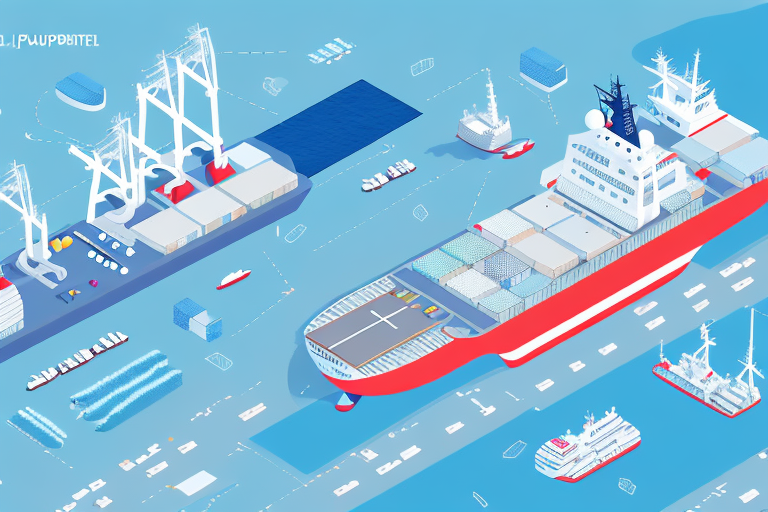Understanding the ISPS Code: A Guide to International Ship and Port Facility Security in the Supply Chain
In today’s globalized world, the security of maritime transportation is crucial for the smooth functioning of the supply chain industry. To ensure the safety of shipping vessels and port facilities, the International Maritime Organization (IMO) developed a set of regulations known as the International Ship and Port Facility Security (ISPS) Code. In this article, we provide a comprehensive guide to the ISPS Code and its significance in the supply chain industry.
Why the ISPS Code Was Implemented and Its Importance in the Supply Chain
The ISPS Code was implemented in the aftermath of the September 11, 2001 terrorist attacks in the United States. The IMO recognized that the threat of terrorism posed a significant risk to the security of shipping vessels and port facilities around the world. The purpose of the ISPS Code is to ensure the safety and security of ships, cargo, and port facilities and prevent security incidents that could impact the supply chain. Compliance with the ISPS Code is mandatory for all ships and port facilities engaged in international trade.
One of the key components of the ISPS Code is the requirement for ships and port facilities to develop and implement security plans. These plans must identify potential security threats and outline measures to prevent and respond to security incidents. Regular security drills and exercises must also be conducted to ensure that all personnel are prepared to respond to security threats.
The implementation of the ISPS Code has had a significant impact on the supply chain. While compliance with the Code can be costly and time-consuming, it has helped to improve the security of shipping vessels and port facilities around the world. This has increased confidence in the safety and reliability of the supply chain, which is essential for the global economy. The ISPS Code has also helped to facilitate international trade by ensuring that ships and port facilities meet a consistent set of security standards.
Overview of the ISPS Code Requirements for Ships and Port Facilities
The ISPS Code requirements for ships and port facilities are structured around two levels of security: Level 1 and Level 2:
- Level 1: Basic security measures, such as the use of ID cards, access control, and surveillance systems.
- Level 2: Additional measures in response to specific security threats, which may include the use of armed guards, enhanced screening procedures, and the implementation of restricted access zones.
It is important to note that the ISPS Code requirements are not only applicable to large commercial vessels, but also to smaller vessels, such as pleasure craft and fishing boats. These vessels must also comply with the security measures outlined in the ISPS Code, although the specific requirements may vary depending on the size and type of the vessel.
In addition to the security measures outlined in the ISPS Code, ships and port facilities must also conduct regular security assessments and develop security plans to address any identified vulnerabilities. These plans must be reviewed and updated on a regular basis to ensure that they remain effective and relevant to the current security environment.
The Role of Security Officers in Implementing the ISPS Code
Security officers play a critical role in the implementation of the ISPS Code. Their responsibilities include coordinating security measures and ensuring compliance with the Code’s requirements. Security officers must be properly trained and experienced in security-related matters. They are responsible for ensuring that all security requirements are implemented efficiently and effectively.
In addition to their primary responsibilities, security officers also play a key role in identifying potential security threats and vulnerabilities. They must be vigilant and proactive in their approach to security, constantly assessing and analyzing the security situation to identify any potential risks. Security officers must also be able to communicate effectively with other stakeholders, including port authorities, shipping companies, and law enforcement agencies, to ensure that security measures are coordinated and effective.
Common Challenges Faced by Ship and Port Operators in Complying with the ISPS Code
Ship and port operators often face several challenges in complying with the ISPS Code. Some common challenges include:
- Financial burden associated with implementing the Code’s security requirements.
- Lack of understanding of the Code’s requirements.
- Inadequate training in security-related matters.
- Difficulty balancing security measures with the smooth flow of cargo and the operation of the supply chain.
Another challenge faced by ship and port operators in complying with the ISPS Code is the constantly evolving nature of security threats. As new threats emerge, operators must adapt their security measures to ensure compliance with the Code. This can be a time-consuming and costly process, as it may require the implementation of new technologies or the hiring of additional security personnel.
Best Practices for Implementing Effective Security Measures in Accordance with the ISPS Code
Implementing effective security measures requires a well-planned approach that aims to balance security requirements with supply chain efficiency. Some best practices for implementing effective security measures include:
- Conducting thorough risk assessments.
- Incorporating technological solutions such as scanners and networking systems.
- Coordinating closely with regulatory authorities, shipping companies, and other stakeholders.
Another important aspect of implementing effective security measures is ensuring that all personnel involved in the supply chain are properly trained and aware of security protocols. This includes training on how to identify and report suspicious activity, as well as regular drills and exercises to test the effectiveness of security measures. Additionally, it is important to regularly review and update security plans to ensure they remain relevant and effective in the face of evolving security threats.
The Impact of Non-Compliance with the ISPS Code on Supply Chain Operations
Non-compliance with the ISPS Code can have severe consequences for supply chain operations, including:
- Detention of ships and port facilities.
- Seizure of cargo.
- Imposition of significant financial penalties.
Furthermore, non-compliance could damage a shipping company’s reputation and result in the loss of customers and business opportunities.
One of the major impacts of non-compliance with the ISPS Code is the disruption of the supply chain. When a ship or port facility is detained due to non-compliance, it can cause delays in the delivery of goods and raw materials, which can have a ripple effect on the entire supply chain. This can result in lost revenue, increased costs, and damage to relationships with suppliers and customers.
In addition, non-compliance with the ISPS Code can also pose a security risk to the supply chain. Without proper security measures in place, cargo can be vulnerable to theft, tampering, or even terrorism. This can not only result in financial losses but also put the safety of people and the environment at risk.
Case Studies of Successful Implementation of the ISPS Code in Real-World Scenarios
Several case studies have demonstrated the successful implementation of the ISPS Code in real-world scenarios. Examples include:
Port of Rotterdam: Implemented a comprehensive security system that includes access control, surveillance, and communication systems. These measures have greatly improved the security of the port facility while minimizing inconvenience to cargo owners and ship operators.
Port of Singapore: Implemented a layered security system that includes physical barriers, surveillance systems, and regular security drills. This has resulted in a significant reduction in security incidents and has helped to maintain the port’s reputation as a safe and secure facility.
The success of these case studies highlights the importance of implementing the ISPS Code in real-world scenarios to ensure the safety and security of ports and their surrounding areas.
Future Developments and Updates to the ISPS Code and Their Potential Impact on Supply Chain Security
The IMO is continually monitoring the effectiveness of the ISPS Code and updating it as necessary to address emerging security threats. Future developments and updates to the Code could have a significant impact on supply chain security. Such updates may include incorporating new technological solutions and refining security requirements to reflect evolving security threats.
One potential future development of the ISPS Code is the inclusion of more stringent requirements for cyber security. As the use of technology in the shipping industry continues to increase, the risk of cyber attacks on ships and ports also grows. The IMO may therefore update the Code to include specific cyber security measures that must be implemented by all parties involved in the supply chain.
Another potential update to the ISPS Code could be the inclusion of requirements for the screening of cargo and personnel. Currently, the Code primarily focuses on the security of ships and ports, but there is growing concern about the security of cargo and the individuals involved in the supply chain. The IMO may therefore introduce new requirements for the screening of cargo and personnel to ensure that they do not pose a security threat.
Frequently Asked Questions About the ISPS Code and Its Application in the Supply Chain
Some frequently asked questions about the ISPS Code and its application in the supply chain include:
- How do I know if I am required to comply with the ISPS Code?
- What are the consequences of non-compliance with the Code?
- How can I ensure that my security measures are sufficient to comply with the Code’s requirements?
Comprehensive answers to these and other frequently asked questions are available on the IMO’s website.
In conclusion, the ISPS Code plays a critical role in enhancing the security of maritime transportation and the supply chain. Compliance with the Code’s requirements is mandatory for all ships and port facilities engaged in international trade. Effective implementation of the Code’s requirements requires a well-planned approach that balances security requirements with supply chain efficiency.
It is important to note that the ISPS Code is not a one-time compliance requirement. Regular audits and assessments are conducted to ensure that ships and port facilities continue to meet the Code’s requirements. These audits are conducted by recognized security organizations and failure to pass an audit can result in the suspension of a ship or port facility’s ability to operate in international trade. Therefore, it is crucial for all stakeholders in the supply chain to remain vigilant and continuously assess and improve their security measures to ensure compliance with the ISPS Code.






















